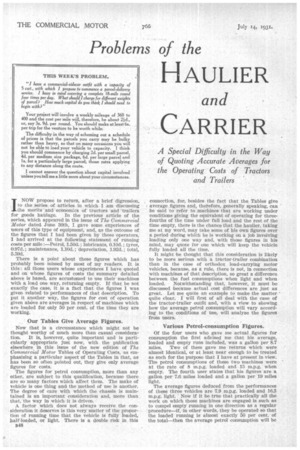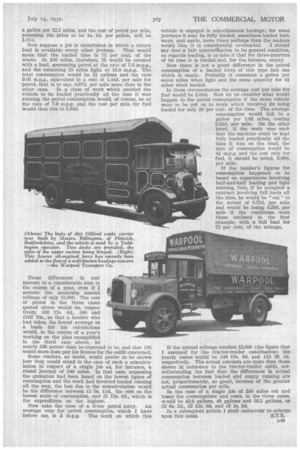Problems of the
Page 66

Page 67

If you've noticed an error in this article please click here to report it so we can fix it.
HAULIER
and
CARRIER
A Special Difficulty in the Way of Quoting Accurate Averages for the Operating Costs of ,Tractors and Trailers INOW propose to return, after a brief digression, to the series of-articles in which I am discussing the merits and economics of tractors 'and -trailers for goods haulage. In the previous article of the series, which appeared in the issue of The Commercial Motor dated June 30th, I gave some experiences of users of this type of equipment, and, as the outcome of the figures that I had been given by those operators, I had arrived at the following statement of running costs per mile :—Petrol, 1.500.; lubricants, 0.10d.; tyres, 0.97d.; maintenance, 1.10d.; depreciation, 1.920.; total, 5.590.
There is a point about these figures which has probably been missed by most of my readers. It is this: all those users whose experiences I have quoted and on whose figures of costs the summary detailed above is based, are accustomed to use their machines with a load one way, returning empty. If that be not exactly the case, it is a fact that the figures I was given related to performances of that description. To put it another way, the figures for cost of operation given above are averages in respect of machines which are loaded for only 50 per cent. of the time they are working.
Our Tables Give Average Figures.
Now that is a circumstance which might not be thought worthy of much more than casual consideration. It is, however, quite important and is particularly appropriate just now, with the publication elsewhere in this issue of the new edition of The Commercial Motor Tables of Operating Costs, as emphasizing a particular aspect of the Tables in that, as has been so often pointed out, they give only average figures for costs.
The figures for petrol consumption, more than any other, are subject to this qualification, because there are so many factors which affect them. The make of vehicle is one thing and the method of use is another. The degree of care with which the chassis is maintained is an important consideration and, more than that, the way in which it is driven.
A factor which does not always receive the consideration it deserves is this very-matter of the proportion of running time that the vehicle is fully loaded, half-loaded, or light. There is a double risk in this
DIS
connection, for; besides the fact that the Tables give average figures and, therefore, generally speaking, can be said to refer to machines that are working under conditions giving the equivalent of operating for threefourths of the time under full load and the rest of the time empty, there is the chance that the haulier, taking me at my word, may take some of his own figures over a period during whia he is working on a job involving loading only one way and, with those figures in his mind, may quote for one which will keep the vehicle fully loaded all the time.
It might be thought that this consideration is likely to be more serious with a tractor-trailer combination than in the case of orthodox load-carrying motor vehicles, because, as a rule, there is not, in connection with machines of that description, so great a difference between the fuel consumptions when light and when loaded. Notwithstanding that, however, it must be discussed because actual cost differences are just as great. Let me quote an example to make the matter quite clear. I will first of all deal with the case of the tractor-trailer outfit and, with a view to showing how the average petrol consumption will vary according to the conditions of use, will analyze the figures from users.
Various Petrol-consumption Figures.
• Of the four users who gave Inc actual figures for consumption the first advised me that his average, loaded and empty runs included, was a gallon per 8.7 miles. Two of them gave me returns which were almost identical, or at least near enough to be treated as such for the purpose that I have at present in view. Th-e petrol 'consumptions of these two machines were at the rate of 8 m.p.g. loaded and 15 m.p.g. when empty. The fourth user states that his figures are a gallon per 7.6 miles loaded and a gallon per 19 miles light.
The average figures deduced from the performances of these three vehicles are 7.9 m.p.g. loaded and 16.3 m.p.g. light. Now if it be true that practically all the work an which those machines are engaged is such as to compel empty running in one direction as a regular procedure—if, in other words, they be operated so that the loaded running is almost exactly 50 per cent. of the total—then the average petrol consumption will be a gallon per 12.1 miles, and the cost of petrol per mile, assuming the price to be 1s. ld. per gallon, will be 1.07d.
Now suppose a job is undertaken In which a return load is available every other journey. That would mean that the loaded time is 75 per cent, of the whole. In 100 miles, therefore, 75 would be covered with a load, oonsurning petrol at the rate of 7.9 m.p.g., and the remaining 25 miles light, at 16.3 m.p.g. The total consumption would be 11 gallons and the rate 9.01 m.p.g., equivalent to a cost of 1.44d. per mile for petrol, that is to say, 0.37th per mile more than in the other case. In _a class of work which enabled the vehicle to be loaded practically all the time it was running the petrol consumption would, of course, be at the rate of 7.9 m.p.g. and the cost per mile for fuel would then rise to 1.64d.
These differences in cost amount to a considerable sum in the course of a year, even if I assume the moderate annual mileage of only 15,000. The cost of petrol in the three cases quoted above would be, respectively, 166 17s. 6d., 190 and 1102 10s., So that a haulier who had taken the lowest average as a basis for his calculations would, in the course of a year's working on the plan exemplified in the third ease above, be nearly 136 poorer than he expected to he, and that 136 would more than pay his licence for the outfit concerned.
Some readers, no doubt, would prefer to be shown how they would stand in the case of such a miscalculation in respect of a single job as, for instance, a round journey of 240 miles. In that case, supposing the quotation had been based on the lowest figure of consumption and the work had involved loaded running all the way, the loss due to the miscalculation would be the difference between Os. lid., the cost on the lowest scale of consumption, and 11 12s. 6d., which is the expenditure on the highest.
Now take the case of a 6-ton petrol lorry. An average rate for petrol consumption, which I have before me, is 5 m.p.g. The work on which this vehicle is engaged is miscellaneous haulage; for some journeys it may be fully loaded, sometimes loaded both ways, and again, more times perhaps than the makers would like, it is considerably overloaded. I should say that a fair approxiination to its general condition, as regards loading, is to take it that for three-quarters of its time it is loaded and, for the balance, empty.
Now there is not a great difference in the petrol consumption of a loaded lorry of this type and one which is empty. Probably it consumes a gallon per seven miles when light and the same quantity for 41 miles when loaded.
In those circumstances the average cost per mile for fuel would be 2.60d. Now let us ,consider what would happen to the petrol consumption if the same vehicle were to be put on to work which involved its being loaded for only 50 per cent, of the time. The average consumption would fall to a gallon per 5.03 miles, costing 2.31d. per mile. On the other hand, if the work was such that the machine could be kept fully loaded practically all the time it was on the road, the rate of consumption would he 41 m.p.g. and the cost only for fuel, it should be noted, 3.06d. per mile.
If the haulier's figures for consumption happened to be based on experiences involving half-and-half loading and light running, then, if he accepted a contract involving full loads all the time, he would be " out " to the extent of 0.75th per mile and would be losing 0.29d. per mile if the conditions were those outlined in the first example, with a full load for 75 per cent, of the mileage.
If the annual mileage totalled 15,000 (the figure that I assumed for the tractor-trailer combination) the , yearly losses would be 146 17s. 6d. and 118 5. Od. respectively. The actual amounts are more than those shown in reference to the tractor-trailer outfit, notwithstanding the fact that the differences in actual consumption between loaded and empty running are not, proportionately, so great, because of the greater actual consumption per mile.
In the ease of a single job of 240 miles out and home the consumptions and costs, in the three eases, -cyanid be 42.6 gallons, 48 gallons and 56.5 gallons, or 12 6s. 2d., 12 12s. Od. and 13 is. 2d.
In a subsequent article I shall endeavour to enlarge upon this point. S.T.R.




































































































